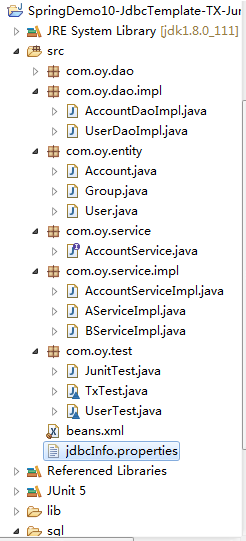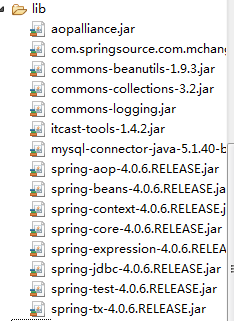1、JdbcTemplate
1.1、搭建环境
1.2、配置DBCP
1.3、配置c3p0
1.4、对dao层的upadate()方法进行测试
1.5、使用JdbcDaoSupport
2、案例
1、JdbcTemplate <--返回目录
spring提供用于操作JDBC工具类,类似:DBUtils。依赖 连接池DataSource (数据源)
1.1、搭建环境 <--返回目录
- 4个核心+1个依赖
- mysql驱动
- spring-jdbc-3.2.0.RELEASE.jar
- spring-tx-3.2.0.RELEASE.jar
- 连接池
com.springsource.com.mchange.v2.c3p0-0.9.1.2.jar c3p0包
或 com.springsource.org.apache.commons.dbcp-1.2.2.osgi.jar dbcp核心包和依赖
com.springsource.org.apache.commons.pool-1.5.3.jar
创建实体类javabean
public class User { private Integer id; private String username; private String password; }
使用api进行测试(了解)
public static void main(String[] args) { //1 创建数据源(连接池) dbcp BasicDataSource dataSource = new BasicDataSource(); // 基本4项 dataSource.setDriverClassName("com.mysql.jdbc.Driver"); dataSource.setUrl("jdbc:mysql://localhost:3306/db_test1"); dataSource.setUsername("root"); dataSource.setPassword("xxx"); //2 创建模板 JdbcTemplate jdbcTemplate = new JdbcTemplate(); jdbcTemplate.setDataSource(dataSource); //3 通过api操作 jdbcTemplate.update("insert into t_user(username,password) values(?,?);", "tom","998"); }
从API的使用,我们知道,jdbcTemplate.update("insert into t_user(username,password) values(?,?);", "tom","998"); 应该写到dao层,并且依赖jdbcTemplate;而jdbcTemplate和数据源都由spring容器提供;
dao层使用JdbcTemplate
public class UserDao{ private JdbcTemplate jdbcTemplate; public void setJdbcTemplate(JdbcTemplate jdbcTemplate){ this.jdbcTemplate = jdbcTemplate; } //添加 public void update(User user){ jdbcTemplate.update("insert into t_user(username,password) values(?,?);", user.getUsername(),user.getPassword()); } //查询所有 public List<User> findAll(){ String sql = "select * from t_user"; return jdbcTemplate.update(sql, ParameterizedBeanPropertyRowMapper.newInstance(User.class)); } }
在sping配置文件中配置dao:dao依赖jdbcTemplate,所以要配置jdbcTemplate;jdbcTemplate依赖datasource,所以要配置datesource;
1.2、配置DBCP <--返回目录
<!-- 创建数据源 --> <bean id="dataSourceId" class="org.apache.commons.dbcp.BasicDataSource"> <property name="driverClassName" value="com.mysql.jdbc.Driver"></property> <property name="url" value="jdbc:mysql://localhost:3306/db_day02_1"></property> <property name="username" value="root"></property> <property name="password" value=""></property> </bean> <!-- 创建模板 ,需要注入数据源--> <bean id="jdbcTemplateId" class="org.springframework.jdbc.core.JdbcTemplate"> <property name="dataSource" ref="dataSourceId"></property> </bean> <!-- 配置dao --> <bean id="userDao" class="com.itheima.dao.UserDao"> <property name="jdbcTemplate" ref="jdbcTemplate"></property> </bean>
1.3、配置c3p0 <--返回目录
<!-- 创建数据源 c3p0--> <bean id="dataSourceId" class="com.mchange.v2.c3p0.ComboPooledDataSource"> <property name="driverClass" value="com.mysql.jdbc.Driver"></property> <property name="jdbcUrl" value="jdbc:mysql://localhost:3306/db_day02_1"></property> <property name="user" value="root"></property> <property name="password" value=""></property> </bean> <!-- 创建模板, 需要注入数据源--> <bean id="jdbcTemplateId" class="org.springframework.jdbc.core.JdbcTemplate"> <property name="dataSource" ref="dataSourceId"></property> </bean> <!-- 配置dao,需要注入模板--> <bean id="userDao" class="com.itheima.dao.UserDao"> <property name="jdbcTemplate" ref="jdbcTemplate"></property> </bean>
1.4、对dao层的upadate()方法进行测试 <--返回目录
@Test public void fun2(){ String xmlPath = "applicationContext.xml"; ApplicationContext applicationContext = new ClassPathXmlApplicationContext(xmlPath); User user = new User(); user.setUsername("zhangsan"); user.setPassword("123"); UserDao userDao = (UserDao) applicationContext.getBean("userDaoId"); userDao.update(user); }
1.5、使用JdbcDaoSupport
JdbcDaoSupport封装了以下代码:以后,dao类只要继承JdbcDaoSupport就可以了。
private JdbcTemplate jdbcTemplate; public void setJdbcTemplate(JdbcTemplate jdbcTemplate){ this.jdbcTemplate = jdbcTemplate; }
修改如下
public class UserDao extends JdbcDaoSupport { //添加 public void update(User user){ String sql = "insert into t_user(username,password) values(?,?);"; this.getJdbcTemplate().update(sql, user.getUsername(),user.getPassword()); } //查询所有 public List<User> findAll(){ String sql = "select * from t_user"; return this.getJdbcTemplate().query(sql, ParameterizedBeanPropertyRowMapper.newInstance(User.class)); } }
dao 继承 JdbcDaoSupport,之后只需要注入数据源,底层将自动创建模板。所以,修改配置文件:
<!-- 创建数据源 c3p0--> <bean id="dataSourceId" class="com.mchange.v2.c3p0.ComboPooledDataSource"> <property name="driverClass" value="com.mysql.jdbc.Driver"></property> <property name="jdbcUrl" value="jdbc:mysql://localhost:3306/db_day02_1"></property> <property name="user" value="root"></property> <property name="password" value=""></property> </bean> <!-- 配置dao,需要注入数据源--> <bean id="userDao" class="com.itheima.e_jdbcdaosupport.UserDao"> <property name="dataSource" ref="dataSource"></property> </bean>
如果想把applicationContext.xml数据源4大参数存放到properties文件中,做下面步骤:
1) 新建一个jdbcinfo.properties
jdbc.driverClass=com.mysql.jdbc.Driver
jdbc.jdbcUrl=jdbc:mysql://localhost:3306/ee19_spring_day02
jdbc.user=root
jdbc.password=1234
2) 修改applicationContext.xml
<!-- 加载配置文件 "classpath:"前缀表示 src下 (spring的约定) 在配置文件之后通过 ${key} 获得内容 --> <context:property-placeholder location="classpath:com/itheima/f_properties/jdbcInfo.properties"/> <!-- 创建数据源 c3p0--> <bean id="dataSourceId" class="com.mchange.v2.c3p0.ComboPooledDataSource"> <property name="driverClass" value="${jdbc.driverClass}"></property> <property name="jdbcUrl" value="${jdbc.jdbcUrl}"></property> <property name="user" value="${jdbc.user}"></property> <property name="password" value="${jdbc.password}"></property> </bean> <!-- 配置dao,需要注入数据源--> <bean id="userDao" class="com.itheima.e_jdbcdaosupport.UserDao"> <property name="dataSource" ref="dataSource"></property> </bean>
2、案例 <--返回目录

sql
create database db_test1 default character set utf8; use db_test1; create table t_user( id int primary key auto_increment, username varchar(50), password varchar(50), group_id int )engine innodb; insert into t_user(username,password,group_id) values('jack','1234',1); insert into t_user(username,password,group_id) values('rose','5678',2); insert into t_user(username,password,group_id) values('张三','123',1); # 在cmd窗口查看前先设置编码 set names gbk; # 查看所有用户 select * from t_user; ################################## create table t_group( id int primary key auto_increment, name varchar(50) )engine innodb; insert into t_group(name) values('一组'); insert into t_group(name) values('二组'); insert into t_group(name) values('三组');
lib

beans.xml
<?xml version="1.0" encoding="UTF-8"?> <beans xmlns="http://www.springframework.org/schema/beans" xmlns:xsi="http://www.w3.org/2001/XMLSchema-instance" xmlns:context="http://www.springframework.org/schema/context" xmlns:tx="http://www.springframework.org/schema/tx" xsi:schemaLocation="http://www.springframework.org/schema/beans http://www.springframework.org/schema/beans/spring-beans.xsd http://www.springframework.org/schema/context http://www.springframework.org/schema/context/spring-context.xsd http://www.springframework.org/schema/tx http://www.springframework.org/schema/tx/spring-tx.xsd"> <!-- 组件扫描 --> <context:component-scan base-package="com.oy"></context:component-scan> <!-- 加载配置文件 --> <context:property-placeholder location="classpath:jdbcInfo.properties"/> <!-- 创建数据源 c3p0--> <bean id="dataSource" class="com.mchange.v2.c3p0.ComboPooledDataSource"> <property name="driverClass" value="${jdbc.driverClass}"></property> <property name="jdbcUrl" value="${jdbc.jdbcUrl}"></property> <property name="user" value="${jdbc.user}"></property> <property name="password" value="${jdbc.password}"></property> </bean> <!-- 配置Jdbc模板 --> <bean id="jdbcTemplate" class="org.springframework.jdbc.core.JdbcTemplate"> <property name="dataSource" ref="dataSource"></property> </bean> <!-- xml方式管理实现事务管理3步: 1.配置事务管理器 2.<tx:annotation-driven transaction-manager="transactionManager"/> 3.注解@Transacional --> <!-- 配置事务管理器 --> <bean id="transactionManager" class="org.springframework.jdbc.datasource.DataSourceTransactionManager"> <property name="dataSource" ref="dataSource"/> </bean> <tx:annotation-driven transaction-manager="transactionManager"/> </beans>
jdbcInfo.properties
jdbc.driverClass=com.mysql.jdbc.Driver jdbc.jdbcUrl=jdbc:mysql://localhost:3306/db_test1?useUnicode=true&characterEncoding=UTF-8 jdbc.user=root jdbc.password=
User

package com.oy.entity; /** * 用户实体类 * @author oy * @version 1.0 * @date 2018年12月30日 * @time 下午11:16:57 */ public class User { private Integer id; private String username; private String password; private Group group; public Integer getId() { return id; } public void setId(Integer id) { this.id = id; } public String getUsername() { return username; } public void setUsername(String username) { this.username = username; } public String getPassword() { return password; } public void setPassword(String password) { this.password = password; } public Group getGroup() { return group; } public void setGroup(Group group) { this.group = group; } @Override public String toString() { return "User [id=" + id + ", username=" + username + ", password=" + password + ", group=" + group + "]"; } }
Group

package com.oy.entity; /** * @author oy * @version 1.0 * @date 2018年12月31日 * @time 下午7:56:36 */ public class Group { private Integer id; private String name; public Integer getId() { return id; } public void setId(Integer id) { this.id = id; } public String getName() { return name; } public void setName(String name) { this.name = name; } @Override public String toString() { return "Group [id=" + id + ", name=" + name + "]"; } }
Account

package com.oy.entity; /** * @author oy * @version 1.0 * @date 2018年12月31日 * @time 下午10:26:00 */ public class Account { private Integer id; private String username; private Integer money; public Integer getId() { return id; } public void setId(Integer id) { this.id = id; } public String getUsername() { return username; } public void setUsername(String username) { this.username = username; } public Integer getMoney() { return money; } public void setMoney(Integer money) { this.money = money; } }
UserDao
package com.oy.dao; import java.util.List; import java.util.Map; import com.oy.entity.User; public interface UserDao { int add(User user); int update(User user); int delete(Integer id); List<User> findAll(); List<User> find(User user); long count(User user); User findById(Integer id); Map<String, Object> findUserWithGroupByid(Integer id); User findUserWithGroupByid2(Integer id); }
UserDaoImpl
package com.oy.dao.impl; import java.sql.ResultSet; import java.sql.SQLException; import java.util.List; import java.util.Map; import javax.annotation.Resource; import org.springframework.jdbc.core.JdbcTemplate; import org.springframework.jdbc.core.RowCallbackHandler; import org.springframework.jdbc.core.simple.ParameterizedBeanPropertyRowMapper; import org.springframework.stereotype.Repository; import com.oy.dao.UserDao; import com.oy.entity.Group; import com.oy.entity.User; @Repository("userDao") public class UserDaoImpl implements UserDao{ @Resource private JdbcTemplate jdbcTemplate; /** * 添加 */ @Override public int add(User user) { String sql = "insert into t_user(username,password) values(?,?)"; Object[] params = {user.getUsername(),user.getPassword()}; return jdbcTemplate.update(sql, params); } /** * 修改 */ @Override public int update(User user) { String sql = "update t_user set username=?,password=?,group_id=? where id=?"; Object[] params = {user.getUsername(),user.getPassword(),user.getGroup().getId(),user.getId()}; return jdbcTemplate.update(sql, params); } /** * 根据id删除 */ @Override public int delete(Integer id) { String sql = "delete from t_user where id=?"; return jdbcTemplate.update(sql, id); } /** * 查询所有 */ @Override public List<User> findAll() { String sql = "select * from t_user"; return jdbcTemplate.query(sql, ParameterizedBeanPropertyRowMapper.newInstance(User.class)); } /** * 模糊查询 */ @Override public List<User> find(User user) { String sql = "select * from t_user where username like ? and password like ?"; String username = "%" + user.getUsername() + "%"; String password = "%" + user.getPassword() + "%"; return jdbcTemplate.query(sql, ParameterizedBeanPropertyRowMapper.newInstance(User.class), username, password); } /** * 带条件查询总记录数 */ @Override public long count(User user) { String sql = "select count(*) from t_user where username like ? and password like ?"; String username = "%" + user.getUsername() + "%"; String password = "%" + user.getPassword() + "%"; // queryForObject()方法是返回一个对象 // 该方法第二个参数Class<T> requiredType是指定返回对象的类型 return jdbcTemplate.queryForObject(sql, Long.class, username, password); // 下面这句也可以实现同样功能,但是不推荐使用queryForLong()方法 // return jdbcTemplate.queryForLong(sql, username, password); } /** * 根据id查询 */ @Override public User findById(Integer id) { String sql = "select * from t_user where id = ?"; return jdbcTemplate.queryForObject(sql, ParameterizedBeanPropertyRowMapper.newInstance(User.class), id); } /** * 关联查询 */ @Override public Map<String, Object> findUserWithGroupByid(Integer id) { //这种方法弊端:User类和Group类不能有同名属性 String sql = "select u.id,u.username,u.password,g.name from t_user u ,t_group g where u.group_id = g.id and u.id = ?"; return jdbcTemplate.queryForMap(sql, id); } /** * 关联查询 */ @Override public User findUserWithGroupByid2(Integer id) { User user = new User(); Group group = new Group(); String sql = "select u.id,u.username,u.password,u.group_id,g.name from t_user u ," + "t_group g where u.group_id = g.id and u.id = ?"; jdbcTemplate.query(sql, new RowCallbackHandler() { @Override public void processRow(ResultSet rs) throws SQLException { user.setId(rs.getInt("id")); user.setUsername(rs.getString("username")); user.setPassword(rs.getString("password")); group.setId(rs.getInt("group_id")); group.setName(rs.getString("name")); user.setGroup(group); } }, id); return user; } }
AccountDao
package com.oy.dao; public interface AccountDao { int update(String username, int moneyChange); }
AccountDaoImpl
package com.oy.dao.impl; import javax.annotation.Resource; import org.springframework.jdbc.core.JdbcTemplate; import org.springframework.stereotype.Repository; import com.oy.dao.AccountDao; @Repository public class AccountDaoImpl implements AccountDao { @Resource private JdbcTemplate jdbcTemplate; @Override public int update(String username, int moneyChange) { String sql = "update t_account set money = money + ? where username = ?"; return jdbcTemplate.update(sql, moneyChange, username); } }
AccountService
package com.oy.service; public interface AccountService { void transfer(String from, String to, int money); }
AccountServiceImpl
package com.oy.service.impl; import javax.annotation.Resource; import org.springframework.stereotype.Service; import org.springframework.transaction.annotation.Transactional; import com.oy.dao.AccountDao; import com.oy.service.AccountService; @Service("accountService") public class AccountServiceImpl implements AccountService { @Resource private AccountDao accountDao; @Transactional @Override public void transfer(String from, String to, int money) { accountDao.update(from, -money); System.out.println(1/0); accountDao.update(to, money); } }
user 相关CRUD测试
package com.oy.test; import java.util.HashMap; import java.util.List; import java.util.Map; import java.util.Scanner; import org.junit.jupiter.api.AfterEach; import org.junit.jupiter.api.BeforeEach; import org.junit.jupiter.api.Test; import org.springframework.context.support.ClassPathXmlApplicationContext; import org.springframework.dao.EmptyResultDataAccessException; import com.oy.dao.UserDao; import com.oy.entity.Group; import com.oy.entity.User; import cn.itcast.commons.CommonUtils; /** * 功能:测试JdbcTemplate模板的使用*/ class UserTest { ClassPathXmlApplicationContext ctx = null; UserDao userDao = null; @BeforeEach public void setUp() throws Exception { ctx = new ClassPathXmlApplicationContext("beans.xml"); userDao = (UserDao)ctx.getBean("userDao"); } @AfterEach public void tearDown() throws Exception { ctx.close(); } /** * 添加 */ @Test public void test1() { User user = new User(); user.setUsername("小张三"); user.setPassword("124"); userDao.add(user); } /** * 修改 */ @Test public void test2() { // 没有id=3的记录。如果修改id=3的用户,也不报错 User user = new User(); user.setId(1); user.setUsername("jack2"); user.setPassword("222"); Group group = new Group(); group.setId(3); user.setGroup(group); userDao.update(user); } /** * 根据id删除 */ @Test public void test3() { userDao.delete(3); } /** * 查询所有 */ @Test public void test4() { List<User> userList = userDao.findAll(); for (User u : userList) { System.out.println(u); } } /** * 多条件模糊查询 */ @Test public void test5() { User user = new User(); user.setUsername("a"); user.setPassword("2"); List<User> userList = userDao.find(user); if (userList.size() == 0) { System.out.println("没有查询出结果。。。"); return; } for (User u : userList) { System.out.println(u); } } /** * 带条件查询总记录数 */ @Test public void test6() { User user = new User(); user.setUsername("张"); user.setPassword("2"); long count = userDao.count(user); System.out.println("count:" + count); } /** * 根据id查询 */ @Test public void test7() { // 查询id=3的用户,由于t_user没有id=3的记录,报错 // EmptyResultDataAccessException:Incorrect result size:expected 1, actual 0 // EmptyResultDataAccessException这个类在spring-tx.jar里面 // 所以,使用JDBCTemplate时要同时导入spring-jdbc.jar和spring-tx.jar两个包 User u = null; Scanner sc = new Scanner(System.in); System.out.println("请输入一个正整数:"); Integer id = sc.nextInt(); try { u = userDao.findById(id); } catch (EmptyResultDataAccessException e) { System.out.println("异常类型:" + e.getClass().getName()); System.out.println("异常消息:" + e.getMessage()); } if (u == null) { System.out.println("查询id=" + id + "的用户:" + "没有该用户"); } else { System.out.println("查询id=" + id + "的用户:" + u); } sc.close(); } /** * 关联查询方法1:将关联查询sql语句查询出的结果集封装成Map, * 然后将Map映射成两个实体。 * 这种方法弊端:User类和Group类不能有同名属性 */ @Test public void test8() { Map<String, Object> map = new HashMap<String, Object>(); map = userDao.findUserWithGroupByid(1); //User类和Group类有同名属性id,所有查询结果集字段id被自动填充给了User类和Group类的id属性 User user = null; Group group = null; user = CommonUtils.toBean(map, User.class); group = CommonUtils.toBean(map, Group.class); user.setGroup(group); // User [id=1, username=jack2, password=222, group=Group [id=1, name=三组]] // 数据库group的id为3 // 因为User类和Group类有同名属性id,导致映射出错。 System.out.println(user); } /** * 关联查询方法2:将关联查询sql语句查询出的结果集手动封装进两个实体(推荐) */ @Test public void test9() { User user = userDao.findUserWithGroupByid2(1); System.out.println(user);//User [id=1, username=jack2, password=222, group=Group [id=3, name=三组]] } }
account 测试事务
package com.oy.test; import org.junit.jupiter.api.AfterEach; import org.junit.jupiter.api.BeforeEach; import org.junit.jupiter.api.Test; import org.springframework.context.support.ClassPathXmlApplicationContext; import com.oy.service.AccountService; import com.oy.service.impl.AServiceImpl; /* * 功能:测试事务 * * xml方式管理实现事务管理3步: 1.配置事务管理器 2.<tx:annotation-driven transaction-manager="transactionManager"/> 3.注解@Transacional */ class TxTest { ClassPathXmlApplicationContext ctx = null; AccountService accountService = null; @BeforeEach public void setUp() throws Exception { ctx = new ClassPathXmlApplicationContext("beans.xml"); accountService = (AccountService)ctx.getBean("accountService"); aServiceImpl = (AServiceImpl)ctx.getBean("aService"); } @AfterEach public void tearDown() throws Exception { ctx.close(); } /** * 测试事务 */ @Test void test1() { accountService.transfer("jack", "rose", 100); } }
测试spring整合junit
package com.oy.test; import org.junit.Test; import org.junit.runner.RunWith; import org.springframework.beans.factory.annotation.Autowired; import org.springframework.test.context.ContextConfiguration; import org.springframework.test.context.junit4.SpringJUnit4ClassRunner; import com.oy.service.AccountService; /** * 功能:测试spring整合junit * * TxTest类中使用JUnit5测试包,@Test类型:org.junit.jupiter.api.Test; * 本类使用@Test的类型:org.junit.Test;如果使用org.junit.jupiter.api.Test会报错。*/ @RunWith(value=SpringJUnit4ClassRunner.class) @ContextConfiguration(locations="classpath:beans.xml") public class JunitTest { @Autowired AccountService accountService; @Test public void test1() { accountService.transfer("jack", "rose", 100); } }
---
